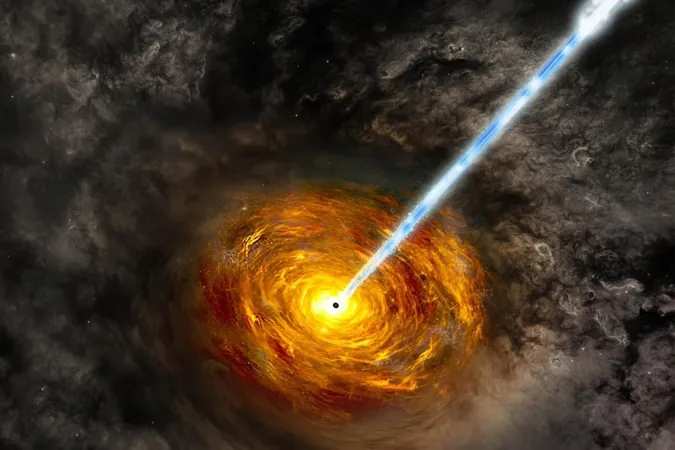
How an Ancient Quasar Illuminated the Universe and Ended the Dark Ages!
2025-01-14
Author: Michael
After the monumental Big Bang that took place approximately 13.8 billion years ago, the universe endured a long and desolate phase known as the Dark Ages. This era, which spanned hundreds of millions of years, was characterized by an absence of light, leaving the cosmos in a state of darkness. However, this all changed dramatically with the onset of the Epoch of Reionization, a revolutionary period marked by the ionization of neutral hydrogen atoms and the birth of the universe's first stars.
A central mystery that has captivated astronomers is the catalyst behind the ionization of hydrogen. Recently, a dedicated team of researchers has uncovered the existence of a powerful quasar that played a pivotal role in this cosmic transformation by emitting vast quantities of X-ray radiation, effectively driving the reionization process.
The Dark Ages set the stage for the universe’s evolution, after which matter was pulled together by gravity, laying the groundwork for the formation of the first galaxies and stars. This profound change began possibly as early as a few hundred million years following the Big Bang. When these primordial stars ignited, they unleashed powerful bursts of radiation that ionized surrounding hydrogen, creating a transparent universe ripe for further development.
Amongst the stellar cast of the early universe, a quasar named J1429+5447 has captured the attention of scientists. Located about 12 billion light-years away in the constellation Lyra, the light we observe from this quasar today offers a glimpse into the cosmos as it was merely 1.6 billion years post-Big Bang. This discovery was announced at a meeting of the American Astronomical Society on January 14, 2023, shining a light on our understanding of the universe's formative years.
The Yale University astronomers utilized the NuSTAR X-ray space telescope to study J1429+5447 and its fascinating behavior. Remarkably, they noted that within a span of just four months, the quasar's X-ray emissions had doubled—a finding that defies conventional expectations in astrophysics. Comparing these observations with earlier data collected using the Chandra X-ray telescope, they were thrust into the depths of a cosmic mystery.
Dr. Meg Urry, a distinguished Professor of Physics and Astronomy, highlighted the extreme variability of X-ray emissions, hypothesizing that this phenomenon results from a relativistic jet—an incredibly fast-moving stream of particles—emanating from the quasar. This jet, traveling near the speed of light, amplifies the emitted radiation in a way that corresponds with Einstein’s theory of special relativity—a true testament to the complex dynamics at play.
These early quasars like J1429+5447 were not just mere cosmic background noise; they were instrumental in transitioning the universe from a dark, barren expanse to a luminous and structured realm. By fostering environments that allowed for the growth and evolution of galaxies, quasars have proven to be cornerstone elements in the epic saga of cosmic history.
In essence, the findings illuminate the critical role that quasars played during the universe's infancy, marking a turning point that ultimately led to the remarkable and richly detailed universe we inhabit today. Stay tuned for more astonishing revelations as the secrets of the universe continue to unveil themselves!



 Brasil (PT)
Brasil (PT)
 Canada (EN)
Canada (EN)
 Chile (ES)
Chile (ES)
 Česko (CS)
Česko (CS)
 대한민국 (KO)
대한민국 (KO)
 España (ES)
España (ES)
 France (FR)
France (FR)
 Hong Kong (EN)
Hong Kong (EN)
 Italia (IT)
Italia (IT)
 日本 (JA)
日本 (JA)
 Magyarország (HU)
Magyarország (HU)
 Norge (NO)
Norge (NO)
 Polska (PL)
Polska (PL)
 Schweiz (DE)
Schweiz (DE)
 Singapore (EN)
Singapore (EN)
 Sverige (SV)
Sverige (SV)
 Suomi (FI)
Suomi (FI)
 Türkiye (TR)
Türkiye (TR)
 الإمارات العربية المتحدة (AR)
الإمارات العربية المتحدة (AR)